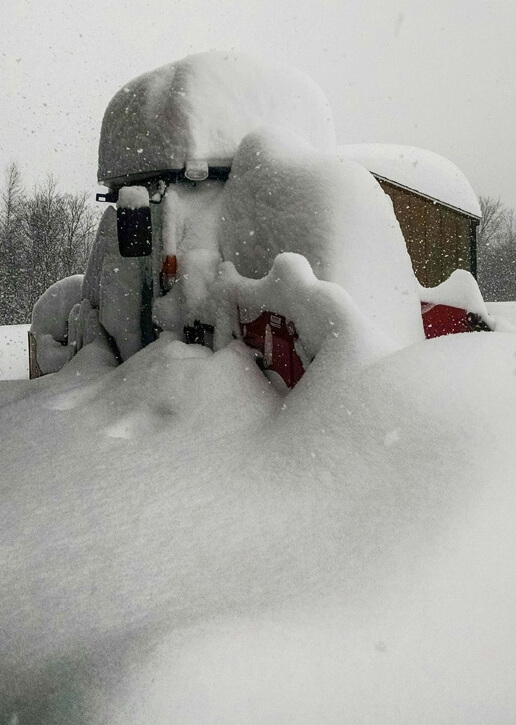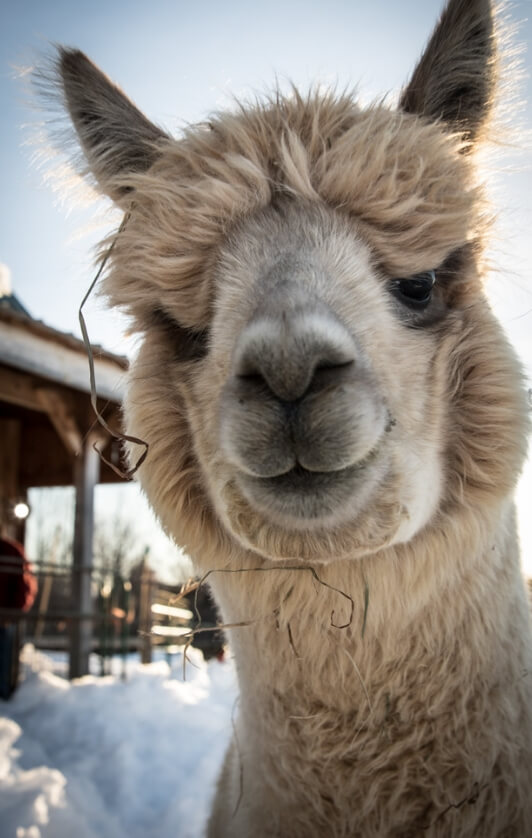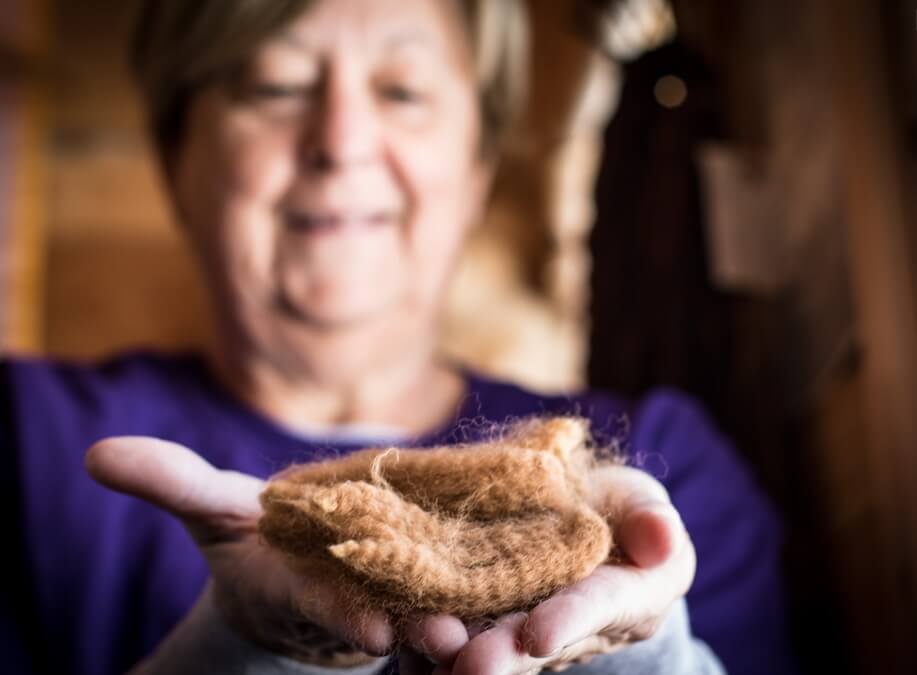Alpacas Are Cool Critters
By Jamie Cole | Photos by Jamie Cole | Courtesy of FarmLife™ / an AGCO® publication

At Marble River Farm in upstate New York, the cute, coltish, quirky alpaca still gets a lot of love.
It’s mid-March, and Sue Holbrook is on the phone, looking out the window at her Marble River Alpaca farm in Chateaugay, N.Y., trying to describe what she sees. “White,” she says. “Just white.” The folks at FarmLife magazine are trying to settle on a time for a visit, and the Holbrooks are wondering if anyone could make it up the drive.

The Holbrook’s Massey Ferguson tractor, buried in snow!
At the moment, Sue’s husband and business partner, Bill, is tending to a herd of alpacas in a custom barn, built with wood he milled himself, that’s maybe 30 yards from the house. It’s more treacherous than it sounds, given the 40 or so inches of snow piled up from a once-in-a-generation blizzard that has made news around the world, and currently has the couple’s shiny new tractor buried in a massive drift; Sue sent us a photo to warn of the storm’s severity. Just white, indeed.
Those alpacas, though … they don’t mind the cold, even if Sue says they may be getting cabin fever from being cooped up. The endearingly low-maintenance ruminants also don’t eat much: less than 2 pounds of hay per day, per 100 pounds of body weight. It doesn’t take Bill very long to feed them. And their, um, potty habits make stall cleanup a bit less of a chore. “Yes, it’s true,” says Sue. “They all poop in the same place.”

Sue and Bill Holbrook at their home on Marble River Farm, an alpaca farm.
And that’s just one of their lovable quirks. Besides their hardiness, manageable appetite and fastidious communal relief spots, they’re remarkably docile. Bud Synhorst, executive director of the Alpaca Owners Association (AOA), says alpacas are an easy entry point to keeping livestock, even for children. “Anyone can put a halter on an alpaca and lead it,” he says. Other line items on the animal’s genteel résumé: They have soft, padded feet. They don’t bite like horses can or butt like goats. When they eat grass, they only nip off the top of the blade. And that manure that you’ll find all in one place? Even that is gentle; by the time food is processed through the animal’s three stomachs, its droppings are nutrient-rich but won’t burn plants, even if applied without composting.
Chores, beyond the easy daily feeding and watering, are typically monthly and yearly. “We clip toenails once a month, and do herd health,” Bill says, like administering parasite medications and vitamins. Shearing is once a year.
Plus, they’re cute. Like, YouTube-viral cute. Search the web for alpaca videos, and you’ll find a sugar-coma level of sweetness. Synhorst admits the alpaca’s good looks are a boon for the brand; they’re the ultimate costars in can’t-miss kids-and-critters clickbait. “I could post a photo of my 6-year-old daughter with an alpaca on Facebook and get a thousand likes like that,” he says, snapping his fingers.
Tough Market
It’s a good thing they’re cute. You’d have to go back to the emu (decidedly not cute) to find an animal so maligned as an agricultural investment by its outspoken critics. In the late ’90s, when the breeding market was peaking, it was commonplace to sell a well-heeled sire for $50,000. Not unlike with high-end horse breeds, even sperm and breeding sessions could command thousands.
That bubble was losing air even before the economic crash of the late ’00s. As the land and housing markets bottomed out, so did the alpaca market. It was no longer feasible to purchase the high-dollar sires and dams as a tax write-off, a practice that added to the animal’s popularity with back-to-landers over the previous two decades since its earliest imports in the ’80s. The mainstream press once used “California alpaca farm” as a euphemism for “tax shelter”; by 2010, the farm press was dismissing the animal as a “cute lawn mower.” Even as recently as 2017, Arizona Senator Jeff Flake was calling alpacas a tax dodge on the popular “Fox and Friends” morning show.
All unfair and uninformed, says Synhorst. In a written response to Flake following the show, Synhorst said Flake was “unprepared” to talk about the North American alpaca industry on TV, and wonders now if the Senator’s comments may have been in jest. “We’ve seen a good comeback” since the economic crisis, says Synhorst, and while the size of the herd in the United States is a matter of some contention—the last ag census in 2012 pinned the number around 141,000—Synhorst says owners have registered some 260,000 animals with his organization. That number doesn’t reflect exports or deaths, and the AOA relies on members to report the death of an animal, but Synhorst says a well-cared-for alpaca can live 15 to 20 years.
Herds Like Family

An alpaca ready for its close-up.
There are some large farms across the country. Synhorst knows of herds numbering 1,500 or more. But many of today’s alpaca farms are on the smaller side, like Marble River, where the Holbrooks’ herd is rarely larger than 20 animals—manageable, practically and economically. “Some people were in it to make money quick, sure,” says Bill. But, he adds, “You don’t make money quick. It’s at least a five-year turnaround on your money. So we’re just starting to get into the money working its way back to us.”
And to say this herd is well cared for is a bit of an understatement. These animals are loved. Bill and Sue still speak about the first alpaca born on their farm—Amy, named after Sue’s mother—like a member of the family. When Amy died suddenly from a blockage, “we were devastated,” says Sue. “Sometimes our kids say we’re in the wrong business,” says Bill, “because we can’t stand to lose one.”
In fact, these small herds are a bit like families. Every animal has a name, and registered animals typically have their family tree traced back five generations. That’s by AOA design, and reflects the animal’s showhorse-like legacy in North America. Registration is still so meticulous that a DNA test is required to prove genealogy.
And while Bill and Sue do indeed train animals for show, today that’s more for community and to show off the “product,” the super-soft, water-repellent, hypoallergenic fiber from the animals’ coats. “The purpose of our farm is really to produce fiber,” says Bill. “The last week of April or the first week of May, we shear.” The fleece has different characteristics depending on the two alpaca breeds from which it’s harvested. Huacaya, the dominant breed in North America, has a dense, crimped coat that yields a more elastic fiber suitable for knitting. The Suri breed has a straighter coat. Both are luxurious, comparable to cashmere but more durable and less expensive. Alpaca fiber can go for $5 to $6 an ounce, compared to around $12 an ounce for cashmere. Lower prices for animals may, in fact, help some owners build a business around fleece if demand grows as expected.

Sue in the farm’s store showing the “crimp” of huacaya alpaca fiber.
Having a business plan is key, say advocates. “Business models vary quite a bit,” explains Synhorst. There is still high-end breeding stock, and “alpaca product is growing, even in high-end fashion design.” Owners might help meet the high-end demand with ever-finer fiber, says Synhorst. “One of the advancements in our industry is using embryo transfer in breeding to advance the level of fiber,” he adds.
And while a small number of farms supply alpaca meat and leather, those are still mostly from culling. Expectedly, Bill winces a bit when asked about eating an animal. “We have tasted it,” he says. “The meat’s good.” The closest comparison is venison—lean, sweet and tender.
The Holbrooks would rather direct you, though, to the store out front on their property, where customers will find everything from raw fiber to milled yarn to scarves and sweaters. Just behind the store, you might catch a glimpse of the Holbrooks’ herd/family. Once they could leave the barn after that crazy blizzard last March, they were loving the snow, says Bill. “It’s really the perfect climate for them.”
Sue agrees. “You’ll see them laying outside during the wintertime, and you can see the steam…”
“The steam is coming out of their little armpits,” Bill finishes. “Like, their little armpits will be frozen.”
Cute, huh? “Gorgeous animals,” says Bill.


